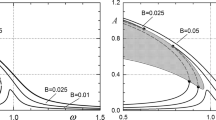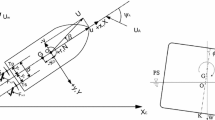Abstract
A double Hopf bifurcation analysis is performed for the rolling of a low-freeboard ship model controlled with an active U-tube anti-roll tank (ART). We consider a single-degree-of-freedom system with nonlinear damping and restoring functions. The ART is modeled as a proportional-gain controller. A constant delay term is included in the controller since a finite amount of time is required to pump the fluid inside the ART from one container to the other. We perform a linear stability analysis to determine the critical control gain and delay corresponding to the double Hopf bifurcation point. We confirm the existence of the double Hopf bifurcation by finding slopes and roots of the characteristic equation of the linearized delay differential equation with the critical parameters. We use the method of multiple scales to obtain slow-flow equations at the double Hopf bifurcation, which are then used to identify six qualitatively distinct sets of fixed points. Our analysis reveals that one of these regions has a stable zero equilibrium, another has a stable limit cycle with amplitude smaller than the capsizing angle, and the remaining regions have no safe fixed points. These qualitative observations are validated numerically. Study of the control of ship roll motion is important to avoid dynamic instability and capsizing.













Similar content being viewed by others
Data availability
Data are available from the corresponding author on reasonable request.
References
Zhou, B., Qi, X., Zhang, J., Zhang, H.: Effect of 6-DOF oscillation of ship target on SAR imaging. Remote Sens. 13(9), 1821 (2021). https://doi.org/10.3390/rs13091821
Holden, C.: Modeling and control of parametric roll resonance. Ph.D. thesis, Department of Engineering Cybernetics, Norwegian University of Science and Technology, Trondheim, Norway (2011). https://hdl.handle.net/11250/260315
Perez, T., Blanke, M.: Ship roll damping control. Annu. Rev. Control. 36(1), 129–147 (2012). https://doi.org/10.1016/j.arcontrol.2012.03.010
Minorsky, N.: Problems of anti-rolling stabilization of ships by the activated tank method. J. Am. Soc. Nav. Eng. 47(1), 87–119 (1935). https://doi.org/10.1111/j.1559-3584.1935.tb04304.x
Marzouk, O.A., Nayfeh, A.H.: Control of ship roll using passive and active anti-roll tanks. Ocean Eng. 36(9–10), 661–671 (2009). https://doi.org/10.1016/j.oceaneng.2009.03.005
Nayfeh, A.H., Khdeir, A.A.: Nonlinear rolling of ships in regular beam seas. Int. Shipbuild. Prog. 33(379), 40–49 (1986). https://doi.org/10.3233/isp-1986-3337901
Nayfeh, A.H., Khdeir, A.A.: Nonlinear rolling of biased ships in regular beam waves. Int. Shipbuild. Prog. 33(381), 84–93 (1986). https://doi.org/10.3233/isp-1986-3338102
Spyrou, K.J., Thompson, J.M.T.: The nonlinear dynamics of ship motions: a field overview and some recent developments. Philos. Trans. A Math. Phys. Eng. Sci. 358(1771), 1735–1760 (2000). https://doi.org/10.1098/rsta.2000.0613
Spyrou, K.J.: Design criteria for parametric rolling. Ocean. Eng. Int. 9(1), 11–27 (2005)
Ibrahim, R.A., Grace, I.M.: Modeling of ship roll dynamics and its coupling with heave and pitch. Math. Probl. Eng. 2010, 934714 (2010). https://doi.org/10.1155/2010/934714
Neves, M.A.S.: Dynamic stability of ships in regular and irregular seas - an overview. Ocean Eng. 120, 362–370 (2016). https://doi.org/10.1016/j.oceaneng.2016.02.010
Vugts, J.H.: A comparative study on four different passive roll damping tanks. Int. Shipbuild. Prog. 16(179), 212–223 (1969). https://doi.org/10.3233/isp-1969-1617903
Shin, Y.S., Belenky, V.L., Lin, W.M., Weems, K.M., Engle, A.H.: Nonlinear time domain simulation technology for seakeeping and wave-load analysis for modern ship design. Trans. Soc. Nav. Archit. Mar. Eng. 111, 557–583 (2003)
Phairoh, T., Huang, J.K.: Modeling and analysis of ship roll tank stimulator systems. Ocean Eng. 32(8–9), 1037–1053 (2005). https://doi.org/10.1016/j.oceaneng.2004.09.007
Alujević, N., Ćatipović, I., Malenica, Š, Senjanović, I., Vladimir, N.: Ship roll control and power absorption using a U-tube anti-roll tank. Ocean Eng. 172, 857–870 (2019). https://doi.org/10.1016/j.oceaneng.2018.12.007
Abdel Gawad, A.F., Ragab, S.A., Nayfeh, A.H., Mook, D.T.: Roll stabilization by anti-roll passive tanks. Ocean Eng. 28(5), 457–469 (2001). https://doi.org/10.1016/S0029-8018(00)00015-9
Moaleji, R., Greig, A.R.: On the development of ship anti-roll tanks. Ocean Eng. 34(1), 103–121 (2007). https://doi.org/10.1016/j.oceaneng.2005.12.013
Kučera, V., Pilbauer, D., Vyhlídal, T., Olgac, N.: Extended delayed resonators - design and experimental verification. Mechatronics 41, 29–44 (2017). https://doi.org/10.1016/j.mechatronics.2016.10.019
Spyrou, K.J.: On course-stability and control delay. Int. Shipbuild. Prog. 46(448), 421–443 (1999)
Shaik, J., Uchida, T.K., Vyasarayani, C.P.: Effect of delay on control of direct resonance of ships in beam waves using a proportional-derivative controller with delay. J. Comput. Nonlinear Dyn. 17(6), 061004 (2022). https://doi.org/10.1115/1.4053561
Yu, P.: Analysis on double Hopf bifurcation using computer algebra with the aid of multiple scales. Nonlinear Dyn. 27(1), 19–53 (2002). https://doi.org/10.1023/a:1017993026651
Moroz, I.M., Brindley, J.: An example of two-mode interaction in a three-layer model of baroclinic instability. Phys. Lett. A 91(5), 226–230 (1982). https://doi.org/10.1016/0375-9601(82)90477-7
Cox, S.M., Leibovich, S., Moroz, I.M., Tandon, A.: Hopf bifurcations in Langmuir circulations. Physica D 59(1–3), 226–254 (1992). https://doi.org/10.1016/0167-2789(92)90217-b
Lewis, G.M., Nagata, W.: Double Hopf bifurcations in the differentially heated rotating annulus. SIAM J. Appl. Math. 63(3), 1029–1055 (2003). https://doi.org/10.1137/s0036139901386405
Marques, F., Lopez, J.M., Shen, J.: Mode interactions in an enclosed swirling flow: a double Hopf bifurcation between azimuthal wavenumbers 0 and 2. J. Fluid Mech. 455, 263–281 (2002). https://doi.org/10.1017/s0022112001007285
Kalmár-Nagy, T., Stépán, G., Moon, F.C.: Subcritical Hopf bifurcation in the delay equation model for machine tool vibrations. Nonlinear Dyn. 26(2), 121–142 (2001). https://doi.org/10.1023/a:1012990608060
Wang, Z., Hu, H.: Dimensional reduction for nonlinear time-delayed systems composed of stiff and soft substructures. Nonlinear Dyn. 25(4), 317–331 (2001). https://doi.org/10.1023/a:1012981822882
Fofana, M.S.: Delay dynamical systems and applications to nonlinear machine-tool chatter. Chaos, Solitons Fractals 17(4), 731–747 (2003). https://doi.org/10.1016/s0960-0779(02)00407-1
Molnar, T.G., Dombovari, Z., Insperger, T., Stepan, G.: On the analysis of the double Hopf bifurcation in machining processes via centre manifold reduction. Proc. R Soc. A Math. Phys. Eng. Sci. 473(2207), 20170502 (2017). https://doi.org/10.1098/rspa.2017.0502
Faria, T., Magalhães, L.T.: Normal forms for retarded functional differential equations and applications to Bogdanov-Takens singularity. J. Differ. Equ. 122(2), 201–224 (1995). https://doi.org/10.1006/jdeq.1995.1145
Faria, T., Magalhães, L.T.: Normal forms for retarded functional differential equations with parameters and applications to Hopf bifurcation. J. Differ. Equ. 122(2), 181–200 (1995). https://doi.org/10.1006/jdeq.1995.1144
Faria, T.: Normal forms for periodic retarded functional differential equations. Proc. R. Soc. Edinb. A Math. 127(1), 21–46 (1997). https://doi.org/10.1017/s0308210500023490
Stépán, G., Haller, G.: Quasiperiodic oscillations in robot dynamics. Nonlinear Dyn. 8(4), 513–528 (1995). https://doi.org/10.1007/bf00045711
Nayfeh, A.H., Chin, C.M., Pratt, J.: In Dynamics and Chaos. In: Moon, F.C. (ed.) Manufacturing Processes, pp. 193–213. Wiley, New York, NY, USA (1997)
Das, S.L., Chatterjee, A.: Multiple scales without center manifold reductions for delay differential equations near Hopf bifurcations. Nonlinear Dyn. 30(4), 323–335 (2002). https://doi.org/10.1023/a:1021220117746
Wahi, P., Chatterjee, A.: Regenerative tool chatter near a codimension 2 Hopf point using multiple scales. Nonlinear Dyn. 40(4), 323–338 (2005). https://doi.org/10.1007/s11071-005-7292-9
Dalzell, J.F.: A note on the form of ship roll damping. J. Ship Res. 22(3), 178–185 (1978). https://doi.org/10.5957/jsr.1978.22.3.178
Wright, J.H.G., Marshfield, W.B.: Ship roll response and capsize behaviour in beam seas. Trans. R. Inst. Nav. Archit. 122, 129–148 (1980)
Kuznetsov, Y.A.: Elements of Applied Bifurcation Theory, 3rd edn. Springer-Verlag, New York, NY, USA (2004). https://doi.org/10.1007/978-1-4757-3978-7
Nayfeh, A.H., Balachandran, B.: Applied Nonlinear Dynamics: Analytical, Computational, and Experimental Methods. Wiley-VCH, Weinheim, Germany (2004)
Pei, L., Wang, S.: Double Hopf bifurcation of differential equation with linearly state-dependent delays via MMS. Appl. Math. Comput. 341, 256–276 (2019). https://doi.org/10.1016/j.amc.2018.08.040
Vyasarayani, C.P., Subhash, S., Kalmár-Nagy, T.: Spectral approximations for characteristic roots of delay differential equations. Int. J. Dyn. Control 2(2), 126–132 (2014). https://doi.org/10.1007/s40435-014-0060-2
Stépán, G., Kalmar-Nagy, T.: Nonlinearregenerative machine tool vibrations. In Proceedings of the ASME 1997 Design Engineering Technical Conferences. Volume 1C: 16th Biennial Conference on Mechanical Vibration and Noise (Sacramento, CA, USA, 1997), p. V01CT12A008. https://doi.org/10.1115/detc97/vib-4021
Stépán, G.: Modelling nonlinear regenerative effects in metal cutting. Philos. Trans. A Math. Phys. Eng. Sci. 359(1781), 739–757 (2001). https://doi.org/10.1098/rsta.2000.0753
Funding
This research received no specific support from any funding source.
Author information
Authors and Affiliations
Contributions
All authors contributed to the conceptualization and design of the study. Mathematical modeling and numerical simulations were performed by JS. The first draft of the manuscript was written by JS. All authors contributed to the review and editing of the manuscript. All authors read and approved the final manuscript.
Corresponding author
Ethics declarations
Conflict of interest
The authors have declared that no competing interests exist.
Additional information
Publisher's Note
Springer Nature remains neutral with regard to jurisdictional claims in published maps and institutional affiliations.
Appendices
Appendix A: Basis functions used in Eq. (17)
The basis functions used in Eq. (17) are the shifted Legendre polynomials, which are defined as follows:
When these basis functions are used, the mass matrices \({\varvec{W}}^{(k)}\) and stiffness matrices \({\varvec{Q}}^{(k)}\) in Eq. (22) have the following simple forms:
Appendix B: Coefficients \(P_i\) in Eq. (32)
The coefficients \(P_i\) appearing in Eq. (32) have lengthy expressions. Thus, we provide here the expressions for only the pertinent coefficients \(P_1\), \(P_2\), \(P_3\), and \(P_4\).
where \(A_i = A_i(T_1)\) and \(\displaystyle {D_1 A_i = \frac{d A_i(T_1)}{d T_1}}\).
Appendix C: Coefficients \(N_i\) in Eqs. (36)
The expressions for the coefficients in Eqs. (36) are as follows:
Rights and permissions
Springer Nature or its licensor (e.g. a society or other partner) holds exclusive rights to this article under a publishing agreement with the author(s) or other rightsholder(s); author self-archiving of the accepted manuscript version of this article is solely governed by the terms of such publishing agreement and applicable law.
About this article
Cite this article
Shaik, J., Uchida, T.K. & Vyasarayani, C.P. Nonlinear dynamics near a double Hopf bifurcation for a ship model with time-delay control. Nonlinear Dyn 111, 21441–21460 (2023). https://doi.org/10.1007/s11071-023-08965-y
Received:
Accepted:
Published:
Issue Date:
DOI: https://doi.org/10.1007/s11071-023-08965-y




